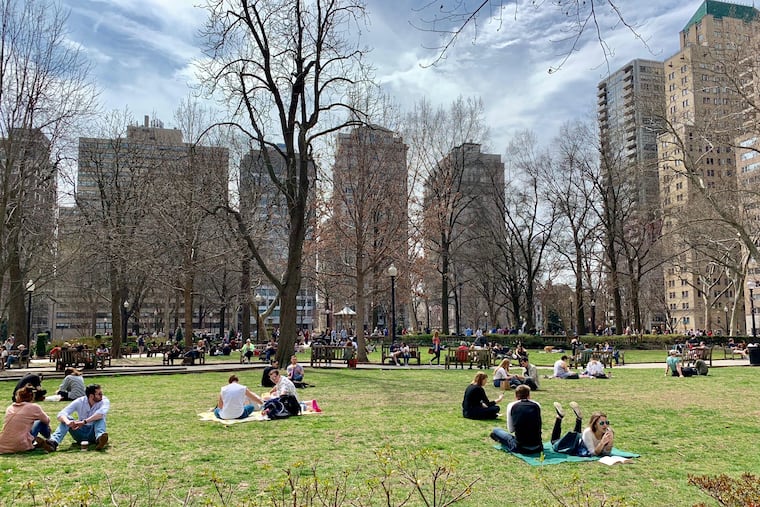In a segregated city, race determines safety. That’s unacceptable. | Editorial
Segregation is at the core of so many of Philadelphia’s problems. How do we move from moral indignation to meaningful action?

In his budget address last month, Mayor Jim Kenney listed the issues facing the city — “a global pandemic, political turmoil at the national level, and intensified violence” — and proclaimed: “We are facing those challenges together.”
That might be true in spirit, but in practice, Philadelphia is not facing all of its challenges together. That is the reality of a segregated city.
» READ MORE: 70% of Philadelphians believe public safety is the most important issue facing the city, poll finds
A new poll by the Pew Charitable Trusts, again, demonstrates this disparity with a statistic that is unacceptable: The percentage of Black and Hispanic Philadelphians who feel unsafe in their neighborhood is double the percentage of white Philadelphians.
According to the Pew poll, more than 60% of white Philadelphians feel “completely or pretty safe in their neighborhoods at night.” Only 32% of Hispanic and 35% of Black Philadelphians were able to say the same. And while more than half of Black and Hispanic Philadelphians said that gun violence had a major impact on the quality of life in their neighborhood, the same was true only for 18% of the city’s white residents.
Roughly a third of all white respondents reported that gun violence had no impact on their life — a privilege that only 12% of Black and Hispanic respondents shared.
This disparity is only possible because Philadelphians of different races don’t share the same neighborhoods — despite more than half a century of lip-service to integration as the policy of the United States.
In 1968, the Kerner Commission, which investigated the unrest of the previous summer, issued a dire warning in its report: “To continue present policies is to make permanent the division of our country into two societies: one, largely Negro and poor, located in central cities; the other, predominantly white and affluent, located in the suburbs and in outlying areas.”
» READ MORE: Philly remains one of the most racially segregated cities in America
On April 11, 1968, about a week after the Rev. Dr. Martin Luther King Jr. was assassinated in Memphis, Tenn., President Lyndon B. Johnson signed the Fair Housing Act into law. Housing discrimination on the basis of race was officially outlawed — on paper.
The Kerner Commission’s report was sadly prophetic. The only thing it failed to anticipate was gentrification and how white city dwellers would go on to create segregated pockets within the heart of big cities. More than half a century after the Kerner Commission and the Fair Housing Act, Philadelphia remains one of the nation’s most diverse and most segregated cities.
What does it mean to be a segregated city in a gun violence crisis? According to the Controller’s Office’s gun violence mapping toll, the zip codes of Rittenhouse Square and Chestnut Hill, where about 70% of the population is white, haven’t experienced a fatal shooting since before 2015. Contrast that with nearly 200 fatal shootings in North Philadelphia-Strawberry Mansion, where more than 90% of the population is Black, or nearly 240 in the Kensington-Port Richmond area, with a Hispanic population of 50%.
Rittenhouse Square is a beautiful park — and a safe one. The Black and Hispanic neighbors of McPherson Square and Hunting Park deserve to feel equally safe in public spaces near their homes.
Segregation is at the core of so many of Philadelphia’s problems — including gun violence, which to this day almost perfectly aligns with the borders of the redlining maps created by the federal government to keep, particularly, Black home buyers out of certain areas.
» READ MORE: Violent Blocks and the Legacy of Redlining in Philadelphia
How do we move from moral indignation to meaningful action? How do we deliver on the promise of fair housing such that we implement what the Kerner Commission called “the integration choice?”
The first step is to retain affordable housing options that already exist (some are being lost now in University City) and creating alternatives to predatory financial institutions for those seeking home loans (such as creating a public bank). But fundamentally, segregation will persist as long as Philadelphia continues to fail to provide basic amenities to all neighborhoods. Good schools, clean streets, open libraries and recreational centers — those shouldn’t be a privilege for the few who can afford it, but a feature of life for all Philadelphians, regardless of zip code.
Gun violence is both a disease and a symptom. It’s crucial that our city’s goal be twofold: ensuring that all Philadelphians feel safe, and that the ranks of those who do not isn’t determined by skin color. Only when that is the case can Philadelphia truly say it is facing its challenges together.